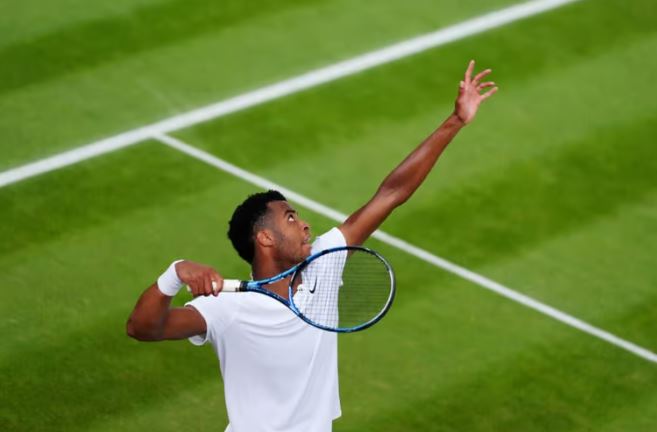In just seven days, Giovanni Mpetshi Perricard has unveiled what is quickly becoming the most lethal shot in tennis. At only 21 years old, the Frenchman’s serve has left opponents struggling to return the ball, let alone win points off it.
Mpetshi Perricard’s serve is a rocket blast that players find nearly impossible to counter. Standing at 6 feet 8 inches (203 cm), he has hit 105 aces in just three matches at the All England Club, including a staggering 51 in his first-round win over Sebastian Korda, the No. 20 seed. With an 85% success rate on his first serve, Mpetshi Perricard has lost only three sets, and only one that wasn’t a tiebreaker. His serve speed ties with Ben Shelton at 140 mph, but it’s his second serve, reaching up to 128 mph, that sets him apart.
“Ridiculous,” is how Shelton describes Mpetshi Perricard’s serve. “He basically hits two first serves.”
This formidable serve has prompted comparisons to tennis legends like Pete Sampras, who dominated with powerful serves. However, the modern era, led by players like Roger Federer, Rafael Nadal, Novak Djokovic, and Andy Murray, has seen a decline in the dominance of big servers. Today’s game demands more versatility, which Mpetshi Perricard is beginning to show.
Mpetshi Perricard isn’t just a “servebot” — a term used to describe players who rely heavily on their serve. He moves well, and his volley is sharp. He has studied big servers, especially John Isner, although he finds watching Ivo Karlovic, another giant of the sport, a bit boring. His diverse skills make him a well-rounded player, not just a one-trick pony.
For a week at Wimbledon, Mpetshi Perricard and his close friend Arthur Fils lived a shared dream. Fils, also a rising star, has been Mpetshi Perricard’s best friend since they were ten-year-olds in France’s national tennis training program. Fils, who has seen and returned more of Mpetshi Perricard’s serves than anyone, managed to reach the fourth round before succumbing to Alex de Minaur. Mpetshi Perricard faced Lorenzo Musetti, a rising Italian player with a strong grass season, who ultimately bested him.
Despite these outcomes, Mpetshi Perricard’s run was remarkable, especially considering he only got into the main draw as a “lucky loser.” After losing in the final round of qualifying, he was given a spot when another player withdrew. He seized the opportunity with no signs of nervousness, focusing on making the most of his unexpected chance.
Mpetshi Perricard’s coach, Emmanuel Planque, emphasizes the importance of aggression in his game. “He doesn’t want to play long rallies,” Planque said. “The goal is to be aggressive from the first shot.” This approach includes coming to the net and serving and volleying, a strategy that has become rare in modern tennis.
Mpetshi Perricard’s one-handed backhand is another unique aspect of his game, though he sometimes envies the two-handed backhand for its ease on returns. Improving his second serve has been a key focus this season, and his efforts are paying off. He varies his second serve, adding spin or targeting different spots to keep opponents off balance.
Against Musetti, Mpetshi Perricard saw firsthand the challenges of facing top-tier players. Musetti won the serve battle, taking 79% of first-serve points compared to Mpetshi Perricard’s 67%. Musetti also excelled in return points, highlighting areas where Mpetshi Perricard can improve.
Despite the loss, Mpetshi Perricard’s serve remains a powerful weapon, likely to challenge top returners for years to come. His rapid rise and potential for growth suggest that he is a player to watch, poised to make a significant impact on the tennis world.

